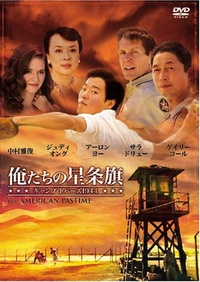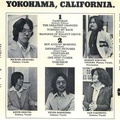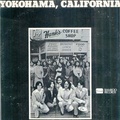This film was shown in Tokyo, but I think there are some people who have not seen it yet, so I would like to introduce the plot. There may be some spoilers, but please forgive me.
Born in Los Angeles, Lyle Nomura is a second-generation Japanese American with first-generation parents. He was the first in his family to receive a scholarship and was expected to attend San Francisco State University. However, on December 7, 1941, his and his family's fate changed completely. Like 120,000 other Japanese Americans, Nomura's family gave up their home, business, and most of their possessions within 10 days of the announcement, and came to the Topaz Internment Camp in the middle of the Utah countryside. They began their life in a barracks in the desert, covered in sand and dirt.
They live surrounded by fences and under constant surveillance. The white guards and soldiers loudly badmouth Japan and the Japanese. Even though there are more Japanese-Americans who were born and raised in America. Kazu Nomura, Lyle's father played by Masatoshi Nakamura, came to America at a young age. At first, he couldn't speak English well and was bullied by everyone. But he became obsessed with baseball, and as he improved, he was able to blend in with the others. The story is set to have played with Babe Ruth in an independent league, but books and research have revealed that there were actually quite a few excellent Japanese-American baseball players. Due to this experience, Kazu decides to start a baseball team in the camp. Lyle's brother and friends help out, and soon the young people's smiles return. At night, men and women dance to the sound of a band playing in the background. The guards grumble when they see the Japanese-Americans having a surprisingly good time. They give them a place to live and food during this war, and they're so obsessed with baseball and jazz...
By chance, Lyle and the prison guard (who is also a sergeant) Billy face off against each other. Lyle is a former college baseball pitcher, and Billy is actually a veteran catcher aiming for the major leagues. Billy insists that a strike is a ball. A mysterious old man (Seth Sakai), who seems to be Issei, tells the frustrated Lyle to "let it go!", which is a gimmick in the story.
Lyle is quite a talented performer and is good at playing the saxophone. One night, while he is performing at a dance hall as usual, Katie, the music teacher at the camp, comes in. She was unable to play the piano without sheet music, but she gradually discovers jazz and begins practicing with Lyle. They get along well... but Katie's father is the prison guard Billy. And her brother is killed in battle in the Marshall Islands. An unrequited love.
Meanwhile, Lyle's older brother volunteers for the Japanese-American unit and heads off to the European front. His mother, in a brilliant performance by Judy Ongg, offers her son a thousand needles. The casting is superb. The mismatch between the Japanese custom of a thousand needles and a second-generation soldier leaving a concentration camp in the United States to fight is also striking. The brother later returns home, but he has lost his right leg. Although he is decorated and reaches the rank of lieutenant, a local white barber refuses to cut his hair. The story reflects the true experiences of Senator Daniel Inouye from Hawaii.
The story ends with a baseball game between the Topaz camp team and a local team. If the Topaz team wins, the brother will have his hair cut by a barber. The cheering voices echo through the Topaz cheering section: "GO FOR BROKE!" "GO FOR BROKE!" With the score tied, in the bottom of the ninth inning, with two outs and a runner on third, Lyle, the runner on third, starts running toward the base... just when you think he's failed to steal home... This film is dedicated to director Desmond Nakano's brother (who joined Regiment 442), and the end credits include the words "In Memory of Noriyuki Pat Morita."
I will write my impressions as they come to mind. The scene where Franklin Roosevelt's Pearl Harbor speech is superimposed on news footage of the attack on Pearl Harbor is a bit clichéd and does not depart from the traditional "Pearl Harbor myth" (America Will Never Forget - Pearl Harbor in Memory, by Emily S. Rosenberg, Hosei University Press). However, the fictional parts are made more intense by the inclusion of footage of prewar Japantown and the lives of Japanese Americans, as well as footage actually shot inside the internment camp with a domestic 8mm camera. There are not many films that maintain such a tension between fiction and non-fiction. Also, scenes that are unrelated to the story, such as live-action footage of a girl skating alone on a puddle-like skating rink, are also effective in leading the viewer into the everyday life of the internment camp.
As director Nakano states, the film is also the narrative of two families. In the Japanese-American family in the internment camp, there is an older brother who wants to prove his American identity by volunteering for the military, and a younger brother who has fundamental doubts about the United States, which confines its citizens in internment camps. In the American family, there is a father who entrusts his unfulfilled dream of becoming a major league baseball player to his eldest son, and a daughter who is attracted to Japanese people, goes to college on a scholarship, and tries to leave her closed-off rural town. The eldest son is killed in action against Japan on the southern front. The feelings of the parents who lost their children to the war are heartbreaking. Some prison guards come to respect the 442nd Combat Team, which rescued the Texas battalion. The internment Japanese-Americans regain their pride and confidence as Americans through jazz, Boy Meets Girl, baseball, America's "national pastime," and a spirit of fair play.
What caught my attention was the role played by Seth Sakai, who reminded me of the late Noriyuki Pat Morita, but I was relieved to see that the old man played by Sakai was not a "master of karate and judo," but a suspicious old man who makes moonshine and encourages young people to gamble (although he is actually a serious and wise man). Mr. Miyagi from "The Karate Kid" is also a stereotype.
However, this is not all that happened in the camp. The attention to detail in this film makes you want to see things that don't exist. For example, a group of people who seem to be pro-Japan or draft resisters appear in the first half of the film, but in the scene immediately following, they are transferred by truck to another camp, and there is no mention of what happened to them afterwards. On the other hand, news footage from that time reporting on the training of Unit 442 is inserted many times, and as mentioned above, at the climax, a chorus of "Go for Broke" breaks out.
As a reviewer, I cannot deny these things, nor do I intend to criticize them, but if Director Nakano has the opportunity, I would like him to film the narrative of people who were sent to a different internment camp in his next work. At the end of the film, the injustice meted out to Japanese Americans and the heroic deeds of Unit 442 are explained in words. In this editing style, Director Nakano's strong will to shed light on the dark side of modern American history that is still unknown to many people is apparent. However, if I may say so without fear of being misunderstood, I think that as it stands, the film is leaning too closely to the "orthodox history of Japanese Americans written by the JACL."
Director Nakano's intention to juxtapose various positions and perspectives is largely successful, and there is no doubt that this film ranks among the best films about Japanese American internment camps and Japanese Americans. However, from a director with the ability to produce such high-quality works, one is left wanting more.
"American Pastime" is, of course, a synonym for "baseball." Baseball is not just a sport. However, "American Pastime" also seems to be a metaphor for "war." The United States is constantly at war somewhere in the world. As if it were the pastime of the United States...
© 2007 Minoru Kanda











